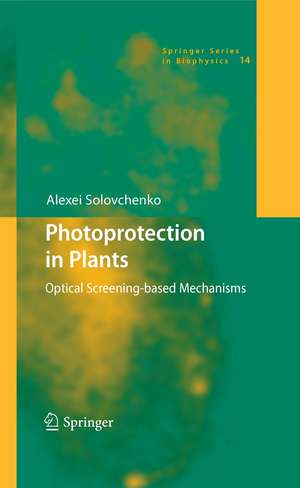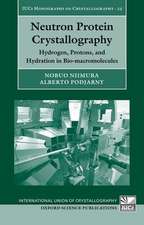Photoprotection in Plants: Optical Screening-based Mechanisms: Springer Series in Biophysics, cartea 14
Autor Alexei Solovchenkoen Limba Engleză Paperback – 6 noi 2012
| Toate formatele și edițiile | Preț | Express |
|---|---|---|
| Paperback (1) | 938.66 lei 6-8 săpt. | |
| Springer Berlin, Heidelberg – 6 noi 2012 | 938.66 lei 6-8 săpt. | |
| Hardback (1) | 943.43 lei 6-8 săpt. | |
| Springer Berlin, Heidelberg – 5 sep 2010 | 943.43 lei 6-8 săpt. |
Din seria Springer Series in Biophysics
- 18%
 Preț: 961.72 lei
Preț: 961.72 lei - 18%
 Preț: 893.84 lei
Preț: 893.84 lei - 18%
 Preț: 958.07 lei
Preț: 958.07 lei - 20%
 Preț: 552.24 lei
Preț: 552.24 lei - 18%
 Preț: 1117.82 lei
Preț: 1117.82 lei - 15%
 Preț: 643.99 lei
Preț: 643.99 lei - 24%
 Preț: 1046.72 lei
Preț: 1046.72 lei - 18%
 Preț: 952.26 lei
Preț: 952.26 lei - 18%
 Preț: 1226.24 lei
Preț: 1226.24 lei - 18%
 Preț: 1230.66 lei
Preț: 1230.66 lei - 20%
 Preț: 551.86 lei
Preț: 551.86 lei - 18%
 Preț: 953.65 lei
Preț: 953.65 lei - 18%
 Preț: 948.16 lei
Preț: 948.16 lei - 15%
 Preț: 645.60 lei
Preț: 645.60 lei - 18%
 Preț: 723.38 lei
Preț: 723.38 lei - 18%
 Preț: 1146.56 lei
Preț: 1146.56 lei - 20%
 Preț: 569.85 lei
Preț: 569.85 lei - 15%
 Preț: 642.51 lei
Preț: 642.51 lei - 15%
 Preț: 644.49 lei
Preț: 644.49 lei - 15%
 Preț: 649.71 lei
Preț: 649.71 lei - 15%
 Preț: 639.59 lei
Preț: 639.59 lei - 18%
 Preț: 951.29 lei
Preț: 951.29 lei - 15%
 Preț: 639.25 lei
Preț: 639.25 lei - 9%
 Preț: 872.34 lei
Preț: 872.34 lei
Preț: 938.66 lei
Preț vechi: 1144.71 lei
-18% Nou
Puncte Express: 1408
Preț estimativ în valută:
179.62€ • 188.00$ • 149.49£
179.62€ • 188.00$ • 149.49£
Carte tipărită la comandă
Livrare economică 31 martie-14 aprilie
Preluare comenzi: 021 569.72.76
Specificații
ISBN-13: 9783642264870
ISBN-10: 3642264875
Pagini: 184
Ilustrații: XIV, 170 p. 80 illus., 18 illus. in color.
Dimensiuni: 155 x 235 x 10 mm
Greutate: 0.25 kg
Ediția:2010
Editura: Springer Berlin, Heidelberg
Colecția Springer
Seria Springer Series in Biophysics
Locul publicării:Berlin, Heidelberg, Germany
ISBN-10: 3642264875
Pagini: 184
Ilustrații: XIV, 170 p. 80 illus., 18 illus. in color.
Dimensiuni: 155 x 235 x 10 mm
Greutate: 0.25 kg
Ediția:2010
Editura: Springer Berlin, Heidelberg
Colecția Springer
Seria Springer Series in Biophysics
Locul publicării:Berlin, Heidelberg, Germany
Public țintă
ResearchCuprins
Optical Screening as a Photoprotective Mechanism.- Screening Pigments: General Questions.- Stress-Induced Buildup of Screening Pigments.- Localization of Screening Pigments Within Plant Cells and Tissues.- Manifestations of the Buildup of Screening Pigments in the Optical Properties of Plants.- Quantification of Screening Pigments and Their Efficiency In Situ.- Buildup of Screening Pigments and Resistance of Plants to Photodamage.
Recenzii
From the reviews:
“The book is well written and clearly structured in seven chapters. … This book is primarily directed at professionals and experts. … due to its textbook-like character, comprehensible style of writing and well designed figures and cartoons, the book can also provide detailed insight into the role of plant screening pigments to advanced students in plant biology.” (Matthias Gilbert, Journal of Plant Physiology, Vol. 167, 2010)
“The book is well written and clearly structured in seven chapters. … This book is primarily directed at professionals and experts. … due to its textbook-like character, comprehensible style of writing and well designed figures and cartoons, the book can also provide detailed insight into the role of plant screening pigments to advanced students in plant biology.” (Matthias Gilbert, Journal of Plant Physiology, Vol. 167, 2010)
Textul de pe ultima copertă
Optical screening of excessive and potentially harmful solar radiation is an important photoprotective mechanism, though it has received much less attention in comparison with other systems preventing photooxidative damage to photoautotrophic organisms. This photoprotection in the form of screening appears to be especially important for juvenile and senescing plants as well as under environmental stresses—i.e. in situations where the efficiency of enzymatic ROS elimination, DNA repair and other ‘classical’ photoprotective systems could be impaired.This book represents an attempt to develop an integral view of optical screening-based photoprotection in microalgae and higher plants. Towards this end, the key groups of pigments involved in the screening of ultraviolet and visible components of solar radiation in microalgae and higher plants, and the patterns of their accumulation and distribution within plant cells and tissues, are described. Special attention is paid to the manifestations of screening pigment accumulation in the optical spectra of plants. It is also demonstrated that understanding these effects and their relationships to screening pigments’ makeup and spectroscopy in plants provides valuable insights into the state of plants’ long-term photoacclimation, as well as ample opportunities for the non-destructive quantification of screening pigments and the assessment of the efficiency of photoprotection providing by these pigments in situ.
Caracteristici
The book summarises the current knowledge on photoprotection of plants via optical screening of solar radiation in the UV and visible parts of the spectrum by extrathylakoid pigments Special attention is paid to the effects of screening pigment accumulation on plant optical properties The readers find the summary of key screening pigments, their spectral properties in planta and numerous illustrated cases











